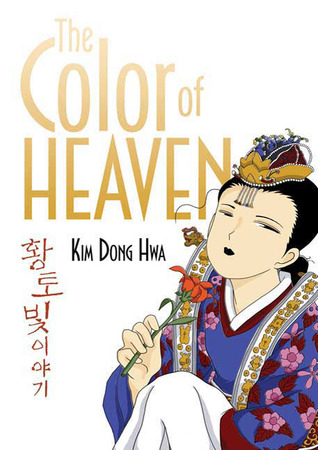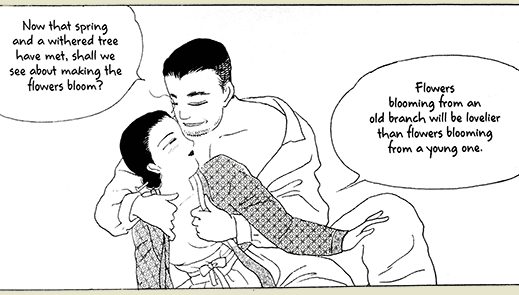Description: Ehwa grows up helping her widowed mother run the local tavern, watching as their customers – both neighbours and strangers – look down on her mother for her single lifestyle. Their social status isolates Ehwa and her mother from the rest of the people in their quiet country village. But as she gets older and sees her mother fall in love again, Ehwa slowly begins to open up to the possibility of love in her life discovering along the way the pain of heartbreak – and that love is always complicated.
Stats: Young Adult Manhwa, Compete Series Books 1-3, English Editions (Book 1-3) Published by First Second in 2009.
My Overall Rating: 3 STARS
In The Color of Earth series we take an intimate look into the journey to womanhood. What strikes me now that I've completed the series is just how true it rings to early curiosity and the awkward cautiousness of growing up. In the time when this book is set in rural Korea you obviously can't just Google your questions away like we can now. Learning about the unknown was a much more communal experience as you gossip with your friends and covertly ask your mother questions. It's easier not to blush in front of your computer screen. It's through this setting of a more innocent time that we see the first blush of growing up without all the answers. I feel like that is the power of this book. The combination of narrative and education is something that is indispensable to a young adult audience.
Throughout the book it uses various metaphors to have frank and honest discussions about sensitive topics, which would otherwise be frowned upon. It was used in an interesting and informative way that made its intent clear without being explicit. It's all butterflies and flowers! Unfortunately, it is this very use of metaphor that dragged the story down. What starts off as interesting and quaint eventually turns into overwhelming as every begins to relate back to being a butterfly, or blooming like a flower, or a butterfly landing on a blooming flower in the snow. It's as if the author got a little too wrapped up in his language, which may have been better in the original Korean. It's impossible to say how much of the boring, drawn out metaphors were intentional or accidentally created in the translation process. Either way, I often found myself increasingly bored with each book, finally ending in frustration.
On the other hand, I simply could not bring myself to put these books down and the art had a lot to do with my continued interest. Every page was gorgeous, even in simple black and white. The beauty of settings and the wonderfully drawn characters keeps your eyes on the page. Everything was stunning to look at and I frequently found myself coming back and re-read pages just to stare at the artwork with all its wonderful details. You could sense the setting and the way the characters moved. The expression were always more revealing than the text and a character's body language spoke volumes about what wasn't really being said.
I would recommend this book if not solely on the value of the art itself, regardless of any problems I had with the storytelling and that is truly saying something.
 |
| Ehwa and her Mother |
I think what has me feeling the most positive about this series is due to Kim Dong Hwa himself. Despite being male and having his words go through the filter of translation I could not tell this was written by a man. His ability to write from a woman's perspective in a way that is both honest and respectful of what it means to be a woman is frankly a rather amazing feat. This may be in part due to that fact that he is drawing from a very personal place as he re-imagines what his mother's youth must have been like using her experiences as inspiration for the story.
It's probably also for this reason that the mother-daughter relationship really stands out. The way these two learn from each other and care of each other is unlike what I'm used to seeing. According to fiction, in all forms, there is no such thing as the supportive mother. Mother-daughter relationships are more likely to be fraught with conflict, disappointment, and is something that only a highly trained therapist can truly fix. Here, Ehwa's mother doing her best to raise her daughter and guide her through growing up by giving her the space and freedom to do so. Of all the messages in this series about growing up I feel like their relationship is one of the more important ones.
Then of course I feel I have to mention the most overwhelming negative I walked away with from this series. I know it's a pain, but publishers, when publishing something in Canada it would rock if you could spell colour correctly. I believe that you are truly doing a disservice to your moral obligation in properly educating our youth by teaching them such vulgar misspellings and harming their development. I think it's unacceptable and I believe libraries and book sellers should be required to add a U to the title before placing it front and centre in the YA department in order to remedy this grave error in judgement.
Speaking of grave errors in judgement, for the some odd years since The Color of Earth has been published in North America it has come under fire becoming commonly listed among banned and challenged books. On the ALA's yearly list of the top ten challenged books, The Color of Earth was #2 in 2011 for the reasons of "nudity; sex education; sexually explicit; unsuited to age group", but not for it's misspelling of "colour". Shocking!
Of course the problem lies for these petulant few in that The Color of Earth is a graphic novel series aimed towards a YA audience that talks about sex, through the explicit language of the previously mentioned flowers, peppers, butterflies, and chestnut trees. In the few occasions that characters are actually getting naked I found it no more graphic then what I've come to expect from the front covers of comics about Wonder Woman or Power Girl.
When it comes to teaching those in the young adult age range I feel books like these ones are important. I also find it a little ridiculous that people are trying to ban a book that in itself is a more innocent and conservative look at sex and love than the majority of media out there. Thankfully, on the ALA's yearly list for 2012 The Color of Earth series was not among the top ten. I highly encourage everyone to go and check out the list, inform yourselves about the censorship of these challenged books, and then go out of your way to read them!
If you would like to read my individual reviews which go into much more detail about the positives and negatives of the series then you can check those out on Goodreads here:






i relate to that....
ReplyDelete